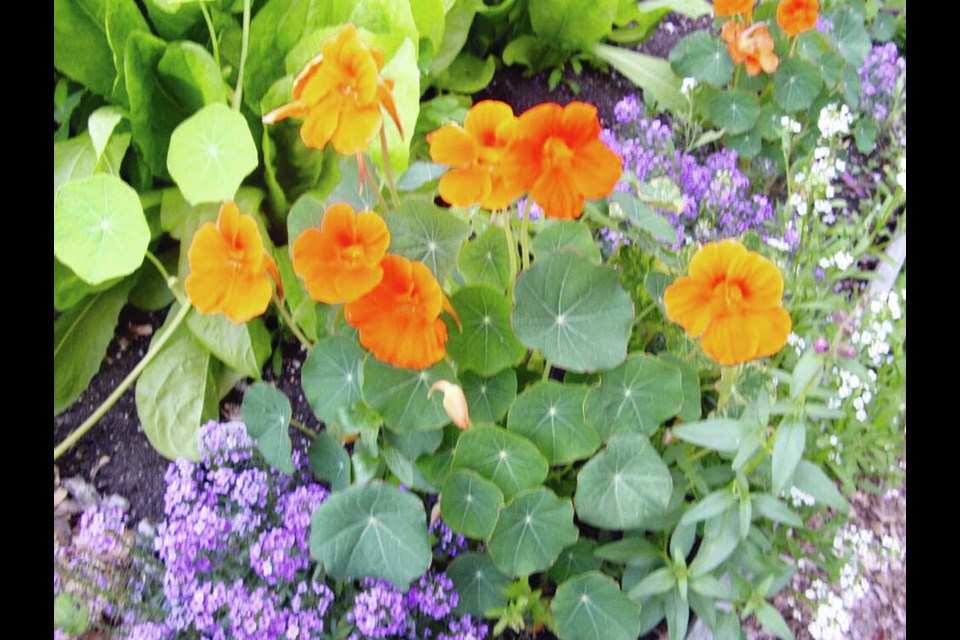They had to be planted. Lettuces, if allowed to become overgrown and leggy in their flats, rarely grow to produce the robust and succulent heads we relish in these essential salad greens.
They were new and unusual varieties I was trying. One, called Mayan Jaguar, is described as a sturdy, compact, crunchy romaine with a blush pink heart and ruffled green leaves speckled in dark red.
Camo Oakheart, of red romaine and green oakleaf parentage, produces dense heads of small leaves from deep red to plain green with some plants displaying variable red and purplish speckling.
My problem: It was the first week of August. The weather had been fiercely hot — too hot for lettuce transplanting. What to do?
I also had snow pea seeds waiting to be planted. Peas don’t germinate well in hot soils.
I’d left in place the wire fencing that had supported the first planting of shelling peas. I decided to go ahead and plant them, on the south side of the support, after amending the soil with compost and moisture-retaining coconut fibre (coir) and watering the site well. I then transplanted the lettuces on the other side of the fencing, while it was still cool one morning.
For shelter from the hot sun, I turned to my collection of cardboard on hand for weed suppression on pathways. I found a few sturdy pieces to lean against the wire’s south side, shading both the seeded snow peas and the lettuces. Each afternoon, as the sun moved toward the west, I leaned more cardboard against the other side of the wire fencing to shade the transplants from the late afternoon sun.
The system doesn’t look very pretty, but it seems to have worked. All 14 transplants are looking perky. I’ll continue the shading until the lettuces begin filling out and the weather cools a little more.
Barbara Dibley and Baby Orange. In the early days of this garden, a clematis vine grew on a trellis set up alongside the path leading past the carport and into the back garden. The clematis was Barbara Dibley, a large-flowered mauve variety with reddish-violet lengthwise markings along the centre of each petal.
As the garden evolved, for more convenient care of the bed beside the carport, I took away the trellis and moved the clematis to the base of a flowering quince shrub in a small bed beside the path to the greenhouse. The bed is a minimally tended plot of low ground covers, a tall ornamental grass, hardy geraniums, and a smoke bush against the fence.
The Barbara Dibley vine, despite its lack of care, never fails to produce clusters of showy early summer flowers floating through and atop its support shrub on strong, wiry stems.
Among the new annual flower varieties I’m growing this summer, the star of the show so far is Baby Orange nasturtium, a European Fleuroselect award winning plant for its compact habit. The bright, rich orange flowers contrast beautifully with the dark green leaves.
Baby Orange is the most compact nasturtium I’ve ever grown. I used it to edge one side of the centre path through the vegetable garden. First, I planted purple alyssum at evenly spaced intervals along the edge, and then seeded the nasturtium in between.
That floral edging developed quickly and has remained tidy and colourful through the summer so far. It was an easy project too, taking only a few minutes to plant.
GARDEN EVENTS
Dahlia show. The Victoria Dahlia Society is holding its 76th Annual Flower Show on Saturday, Aug 27, from 1 to 4 p.m. and Sunday, Aug. 28, from 12 to 4 p.m. The show is at Prospect Lake Community Hall, 5358 Sparton Rd., Victoria. Admission is free. Come and view a dazzling display of dahlias grown by club members
Russell Nursery events.
* Saturday, Aug. 27, at 10 a.m. or 2 p.m. Join co-owner Sue Tice for a behind-the-scenes tour of the nursery. Find out how perennials, shrubs and trees are potted, and visit the places where plants are grown to saleable size. Register for the tour by phoning 250-656-0384 or email russellnursery@telus.net.
* Sunday, Aug. 28, 12 to 3 p.m. A drop-in question and answer time with David Spencer from Applied Bionomics. Learn how to use beneficial insects and mites as well as other bio-controls to deal with garden pests. No need to register for this.



